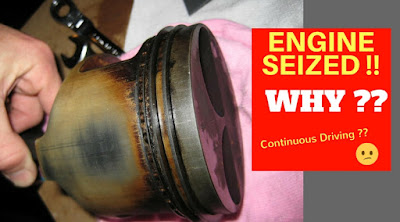Engine seize is a condition when engine stops working due to some external or internal cause.In other words,engine seize is when some portion of the engine has lost lubrication and the moving parts have started to abrade each other, either from friction, heat or mechanical failure (example: broken piston ring) to the point that the engine stops turning.Unusual engine noises, low oil pressure, engine overheating, loss of power, misfiring, hard starting and similar driveability and performance complaints can all be indications of problems that need attention.
Causes of Engine Seize :
The major causes of engine failures can be lumped into four basic categories:
- Overheating (excessive heat)
- Lubrication (or the lack thereof)
- Detonation (Spark Knock )(Detonation)
- Misassembly
1.Overheating:
Overheating can be caused by any number of things. It is often the result of coolant loss or a low coolant level, which is turn may be due to leaks in hoses, the radiator or the engine itself. A weak radiator cap that leaks pressure can allow coolant to escape from the system. Not getting the cooling system completely filled after changing the antifreeze can allow steam pockets to form that make the engine overheat or run hot. An electric cooling fan that fails to come on due to a faulty thermostat, relay, wiring or motor may be an overlooked cause of overheating. So too can a slipping fan clutch. Even a missing fan shroud that reduces the fan's effectiveness may be a contributing factor.
Too much heat in an engine can cause serious problems because heat causes metal to expand. The hotter the engine gets, the tighter clearances become until there are no more clearances left. Overheating can cause valve stems to gall and stick, and pistons to scuff and seize. So if you see either of these conditions when you tear the engine down, it is a pretty good clue that overheating caused the engine to fail.
2.Lubrication:
Every engine needs oil between its moving parts not only to reduce friction but also to carry away heat. Oil is the primary means by which the rod and main bearings are cooled, as well as the pistons. So any reduction in oil flow may cause these parts to run hot, gall and seize.Overhead cam engines are even more vulnerable to oil starvation and low oil pressure problems than pushrod engines because the cam and valvetrain are farther from the pump. When an OHC engine is first started, it takes awhile for oil pressure to reach the cam bearings.
If you suspect engine damage may have been caused by a low oil level, check the dipstick to see how much oil is in the pan. A low oil level may be the result of neglect, oil leakage and/or oil burning.
3.Detonation:
Detonation (Spark Knock ) is a form of abnormal combustion that results from too much heat and pressure in the combustion chamber. The fuel ignites spontaneously causing a sudden rise in cylinder pressure. The result is a sharp hammer-like blow on the piston that produces a metallic knocking or pinging noise. Light detonation is considered normal and should not cause any damage, but heavy or prolonged detonation can crack rings, pound out piston ring grooves, punch holes through the tops of pistons, smash rod bearings and blow head gaskets.
Causes of detonation include excessive compression, elevated engine operating temperature, preignition, overadvanced ignition timing (spark knock), lean fuel mixture, spark plugs that have too hot a heat range for the application, low octane fuel, and even bad driving habits such as lugging the engine excessively with a manual transmission.
4. Misassembly:
You can probably ignore misassembly as a factor in a high mileage engine failure. But in a newly rebuilt engine or a low mileage failure, it should certainly be considered as a possibility. Some common mistakes to look for:
- Incorrect engine bearing clearances (too tight or too loose). Galling or seizure would tell you bearing clearances were too tight, while fatigue failure would point to excessive clearances.
- Insufficient Valve-to-Piston Clearance, or Piston-to-Cylinder clearance. Not checking clearances may result in valves hitting pistons (especially with high lift cams or rocker arms) or pistons sticking in cylinders.
- Misalignment. If the center main bearings show much greater wear than the end bearings, the crankshaft may be bent or the main bores may be misaligned. The underlying condition must be corrected by straightening or replacing the crank and/or align boring the block. The same applies to camshafts and cam bearings (pushrod & OHC).
- Failure to clean parts properly during engine assembly (not scrubbing out the cylinder bores with soap and water to remove debris and honing residue after they have been bored or honed, for example). Any junk that is left in the engine can scour bearings and wear surfaces.




No comments:
Post a Comment